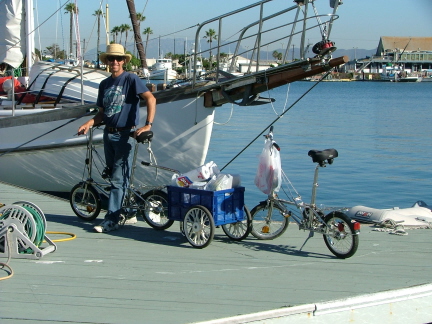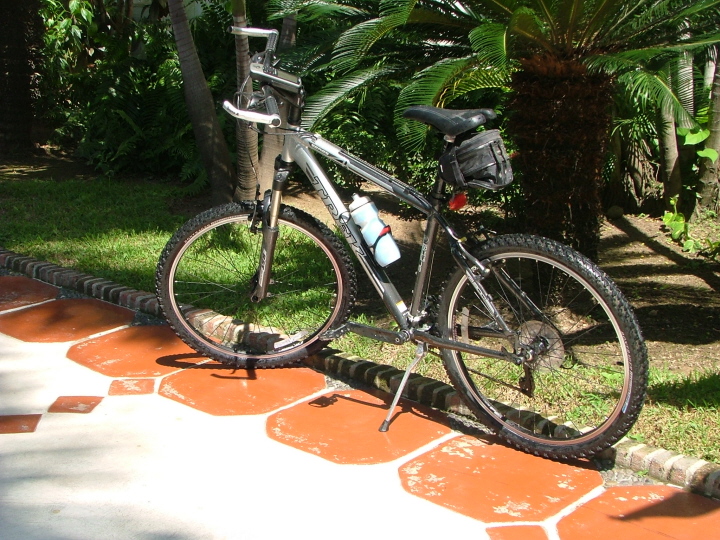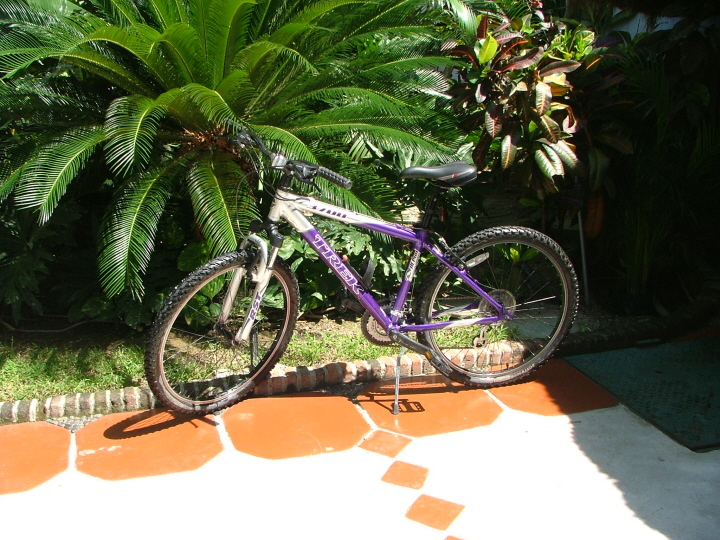
CYCLING
We have owned
bikes as long as we have owned boats, but it was only in 2007
that we started riding for recreation in addition to
transportation. Up till then we used our folding bikes (16-inch
Dahons in photo on right) for transportation wherever we happened
to anchor or moor.
In the summer of 2005, while Kavenga was baking in the Sonoran desert near San Carlos, Mexico, we were living in our Chevy Class B motorhome back in Gig Harbor. Steve was flipping TV channels at the marina clubhouse one morning when he happened upon the Tour de France. The strategy and tactics baffled him but the beauty of the peloton (mass of riders) and the surrounding French countryside, plus the fact that Lance Armstrong was attempting to win an unprecedented seventh victory, hooked him into watching the rest of the three-week race. Home again in the summer of 2006, he watched the Tour for a second straight year. Kay became interested and started watching, too.
Finally, after watching a third Tour de France, Steve decided he was missing out on all the fun. Health was another motivation. His metabolism seems to have slowed down and keeping weight off was becoming a struggle. His family has a history of Type 2 diabetes. Cycling seemed to be an ideal way to burn calories and improve cardio-vascular health. So, a few days after the 2007 Tour ended, he took his rusty-trusty 26" Dahon Mariner folding mountain bike "for a ride". Instead of using it as he normally does, to commute to his part-time job at West Marine, he headed out on the back roads around Gig Harbor. That first "ride" was maybe 10 or 12 miles. It wasn't easy. His butt hurt, his hands were numbed, and his legs and lungs complained bitterly on the hills. But there was something about just riding the roads for the pleasure of seeing the trees go by, feeling the body being asked to do more, fantasizing about having the peloton chasing you from a mile back. It felt good enough to try again. Perhaps the next ride was 16 miles, and the one after that 18 or 22.
Riding was becoming more fun, but the pains persisted. The Dahon Mariner is not a bike optimized for riding. It's optimized for folding. However, it's a basic, diamond-framed bike. Steve began looking for ways to make it more comfortable. For the butt, he replaced the original vinyl saddle with a more "ergonomically" designed gel saddle. For his hands, he switched the grips from the basic round handlebar grips to ones that flair out wide and flat to give the palms more surface on which to distribute weight. And finally, to improve the ride as well as speed, he took the fat knobby mountain tires off and put narrower, "slick" road tires on, although they are still much wider than standard road bike tires.
With this set-up Steve convinced Kay to go on the Yelm - Tenino bike trail that follows the right-of-way of an abandoned stretch of railroad track between these two small towns. It was 28 miles or so round trip. Kay made it just fine on her Dahon Mariner (still with its knobby tires) with no complaints, but Steve's posterior was still not happy. Although the Spandex or Lycra outfits that other cyclists wore seemed a little too "clubby" for Steve, he decided it was time to visit a bike shop and see if they held some comfort secret. Was there more to cycling wear than just style and aerodynamics? He discovered bike shorts. They aren't just about being skin tight. They have a big, huge "maxi-pad" called a chamois sewn into them that cushions the butt and groin. He bought a pair of Descente brand shorts and the difference was amazing. One added element increased the comfort another notch--a product called Chamois Butt'r. This water soluble lubricant is designed to further eliminate the chances of chafe. Riding a bike in normal everyday shorts and underwear, with all their seams and hems in bad places, compred to a good pair of bike shorts with Chamois Butt'r is like silk pajamas compared to old fashioned, long wool underwear.
Once the comfort issues were under control (probably too much information), longer rides became not only feasible but appealing. After little over a month of riding, Steve decided to take part in his first organized ride, The Headwaters Century. A century is either 100 statute miles, or 100 kilometers if labeled a "Metric Century". Headwaters offered both. Having never ridden more than 45 miles, Steve opted to go for the metric, or about 65 miles. A shorter 44-mile loop was also offered, but part of the appeal of the metric was the challenge of riding quite a bit further than he had to that point.
The Headwaters ride is a series of loops that begin and end in Enumclaw, Washington. When Steve arrived at the start he wasn't surprised to find that he was one of the few riding a mountain bike, in fact, there might have been only one or two other riders on MTBs out of hundreds of riders. But with the slick tires, and great weather he was able to complete the 100 kilometer, semi-hilly course at an average speed of 13.5 mph., somewhere in the middle of the pack. He was tired at the end, to be sure, but not exhausted, and not in any particular pain.
By now it was September and the time for our return to Mexico was drawing near, but there was one more organized ride, the Port Angeles - Sequim, Discovery Trail ride in late September, that our fellow cycling and boating, friend and neighbor, Gail Learned, was planning to ride with her sister and brother-in-law. Steve rode part of the mostly paved trail with them. It was a much easier ride than the Headwaters ride, and the lunch and door prize drawings in Sequim were a lot of fun.
Upon our return to Mexico it took only one short ride on our 16" stainless Dahon Classics (also folders) to convince us that road bikes were not the way to go. This was confirmed when we visited several bike shops and found they had very few if any road bikes for sale. Everyone (exceptions to be noted) down there rides mountain bikes. After a week of shopping, we settled on a pair of Trek "hardtails" (no rear suspension, front fork suspension only).

Here's Steve's Trek 4300a.
He's added bar-ends (those silver horn-like things at the end of the handlebars), and attached the saddlebag from the Dahon Mariner. The bag contains tools, spare inner tube, etc.
There's only one bottle cage on the frame in this photo. He soon added a second, very necessary for riding in Mexico sunshine unless you have one of those hydration backpacks, called CamelBacks.

This is Kay's Trek 3700.
It's a pretty bike, great color.
Why not road bikes you ask? In one word, the answer is "roads". Not having a car to drive out of Puerto Vallarta requires that we always start riding from our home at Marina Vallarta. This immediately means cobblestones. And while it is true that one of the world's most famous road bike races, the Paris - Roubaix is ridden to a large extent on slippery, sometimes, muddy cobblestone, it is not the most comfortable riding surface, especially in a no-suspension road bike.
And once you leave the marina area, the lesser traveled and therefore more desirable roads, are often gravel or even dirt. Road bikes for the most part like pavement. These mountain bikes have pneumatic front suspension and fat knobby tires, which improve not only the comfort of the ride but of course traction as well.
There is one paved route out of Puerto Vallarta suitable for road bikes, and used by a fair number of Mexican riders, that we will touch on in the Mexico page.
The rest of our cycling story continues on the following pages:
- Seattle to Portland 2008